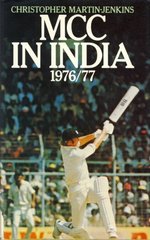MCC in India 1976/77
David Taylor |Published: 1977
Pages: 189
Author: Martin-Jenkins, Christopher
Publisher: MacDonald and Janes
Rating: 3.5 stars

Reading this book again, the account by Christopher Martin-Jenkins of an England tour led by Tony Greig, is of course a poignant exercise. Not just because both passed away recently, in the space of three days in fact, but also because of the way in which Greig threw away the England captaincy, for many the greatest prize in the game, within weeks of the tourists’ return. In the 1975 Wisden Clive Taylor, effusive in his praise for Greig’s efforts in the West Indies, wrote “whatever he did, he did it 100 per cent in England’s cause. He should inspire the side for years to come.” Within two years of those words appearing in print Greig had thrown in his lot with Kerry Packer, but just before doing so he led England on tour for the only time in his career, and inspired his team to a notable victory.
India in the mid-1970s, it should be remembered, were certainly no pushover. Yes they’d been thrashed by Mike Denness’s team in England in 1974, England winning one Test by an innings while losing only two wickets, but at home they were a very different proposition. No England team had won there since Douglas Jardine’s, in the winter after Bodyline. Nigel Howard’s second-string side of 1951-52 scraped a draw, a series that convinced the England selectors that the captain had to be in the side on merit, even if he was a professional like Len Hutton. Ten years later a stronger side led by Ted Dexter lost 2-0, and Mike Smith presided over five draws two years later in one of the dullest series on record, even by 1960s standards. Tony Lewis’s side also lost the series after a suprising win in the first Test.
England had in any case come off a 3-0 spanking by Clive Lloyd’s West Indies, and were in the midst of one of their many rebuilding phases. Many of those who’d been tried in that series were left off the tour, including the Northants pair of Peter Willey and David Steele, both of whom had acquitted themselves well. Willey was young enough to come again but Steele, at 35, must have known his brief but eventful England career was over. Martin-Jenkins writes “the fact is that Steele was unfortunately, even unjustly, treated.”
Three batsmen who had not played in the West Indies Tests were preferred. Graham Barlow and Derek Randall both hit 80s in the one-day series that followed the Tests, and both could be relied on to save many runs in the field. But Keith Fletcher was picked as a ‘spin specialist’ and perhaps also for his tactical know-how, although Mike Brearley was the vice-captain. England clearly exected to encounter turning pitches wherever they went but the reality was that, although the Indian spin trio of Bedi, Chandrasekhar and Prasanna were the leading wicket-takers for the home team and all had averages in the twenties, they were out-performed by England’s quicks – the visitors played three in each Test supported by Underwood, with 29 wickets, and Greig.
The bowler who had most impact on the series, especially in the first three Tests – all won by England – was John Lever of Essex, 27 years old but a newcomer to Test cricket. He took ten wickets on debut as well as making 50, and finished top of the averages with 26 wickets at 14. But in a chapter entitled “Victory and Vaseline” Martin-Jenkins writes of “one of the stranger storms in a tea-cup which from time to time dsiturb the sporting scene” – the complaints by India, and Bedi in particular, but the vaseline gauze briefly worn as a headband by Lever had enabled him to swing the ball and thus gain an unfair advantage. This ignored the fact that Lever had been renowned for his ability to move the ball in the air, in all conditions, for several years, and that he’d been given the headband by physio Bernie Thomas, who was likely to be no more of an expert on swing bowling than Geoff Boycott’s granny.
While perhaps somewhat lacking in distinctive and memorable prose this is an efficient account of an important series, by a man who had much to offer the game in the next 35 years as author, journalist and commentator. There are also full accounts of the several tour matches played, as well as a comprehensive statistical appendix and four sections of photos (but no index). The ‘Post-Mortem’ chapter, giving his conclusions of the tour as a whole, is especially perceptive. At the time of writing ‘CMJ’ had no way of knowing that things were about to change for ever.






Leave a comment